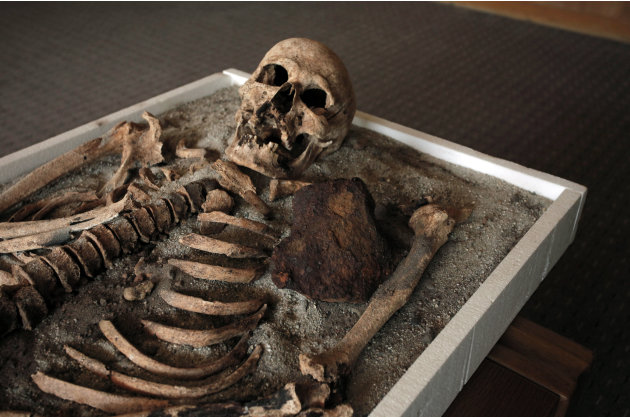
14 June 2012
A 700 year-old skeleton on display at the National History Museum in Bulgaria is thought to be that of a person feared to be a potential vampire.
According to pagan customs at the time, people considered to be bad were stabbed through the heart with an iron rod after death so they could not return as vampires.
Two such skeletons were found at a monastery in the Black Sea city of Sozopol.
Deborah Basckin reports.
According to pagan customs at the time, people considered to be bad were stabbed through the heart with an iron rod after death so they could not return as vampires.
Two such skeletons were found at a monastery in the Black Sea city of Sozopol.
Deborah Basckin reports.
[Image courtesy Wikimedia Commons]
 Photo By Valentina Petrova Thu, Jun 14, 2012 http://news.yahoo.com/photos/photo-of-the-day-slideshow-slideshow/skeleton-dating-back-middle-ages-recently-unearthed-black-photo-160432047.html
Photo By Valentina Petrova Thu, Jun 14, 2012 http://news.yahoo.com/photos/photo-of-the-day-slideshow-slideshow/skeleton-dating-back-middle-ages-recently-unearthed-black-photo-160432047.html

A picture taken on June 14, 2012 shows a skeleton with an iron piece before being exposed at the National History Museum in Sofia. The 700-year-old skeleton -- unearthed in the necropol of a church in the Black Sea town of Sozopol earlier in June -- was stabbed in the chest with an iron rod and had his teeth pulled before being put to rest. (NIKOLAY DOYCHINOV/AFP/Getty Images)
Museum head Prof. Bozhidar Dimitrov has tentatively identified the skeleton as a man named Krivich, who was both a pirate and the mayor of the town of Sozopol where he was buried. When the Genoese besieged the town in the 14th century, Krivich bungled the defense. The town was sacked.
When Krivich died, he was punished for his failings in life by being staked through the chest. According to folk belief at the time, this kept him from becoming a vampire or ascending to heaven.
Even if you don't get a chance to see the dead vampire, the museum is well worth a look. Bulgaria has a rich heritage stretching back to earliest times. I visited the museum when I was excavating a Bronze Age village in Bulgaria and found the collection truly impressive.
In addition to many prehistoric artifacts, there are golden treasures from the Thracian period, fine art from the glory days of the medieval Bulgarian Empire and more modern displays showing the struggle to become independent from the Ottoman Empire.
Besides history, Bulgaria offers beautiful trails in the Balkan Mountains, beaches along the Black Sea and very cool people. It's a country worth visiting.
Read More
Bulgaria finds 'vampire' remains
 “This was a pagan belief widespread in the Bulgarian lands in the 12th to 14th centuries. People were very superstitious then,” National History Museum head Bozhidar Dimitrov said. “This was a pagan belief widespread in the Bulgarian lands in the 12th to 14th centuries. People were very superstitious then,” National History Museum head Bozhidar Dimitrov said.“Throughout the country we have found over 100 such ‘vampire’ burials of mainly noblemen from the Middle Ages who were branded bloodsucking immortals.” Dimitrov explained that these people were considered bad during their lifetime and according to pagan beliefs could become vampires after death and continue to torment the living. “That’s why they were often pierced with rods, wooden or metal,” he said. The Balkan country borders Romania — birthplace of the 15th century ruler often associated with the popular fictional character upon which Dracula is based. Romania’s notorious 15th century ruler Vlad Tepes, or Vlad the Impaler was no vampire, but his cruelty and name inspired the fictional Dracula created by novelist Bram Stoker. The finds in Bulgaria have sparked interest from vampire enthusiasts all over the world and the small Balkan country may seek to capitalise on its pagan heritage. Source: http://www.khaleejtimes.com/displayarticle.asp?xfile=data/diversions/2012/June/diversions_June21.xml§ion=diversions&col= |

No comments:
Post a Comment